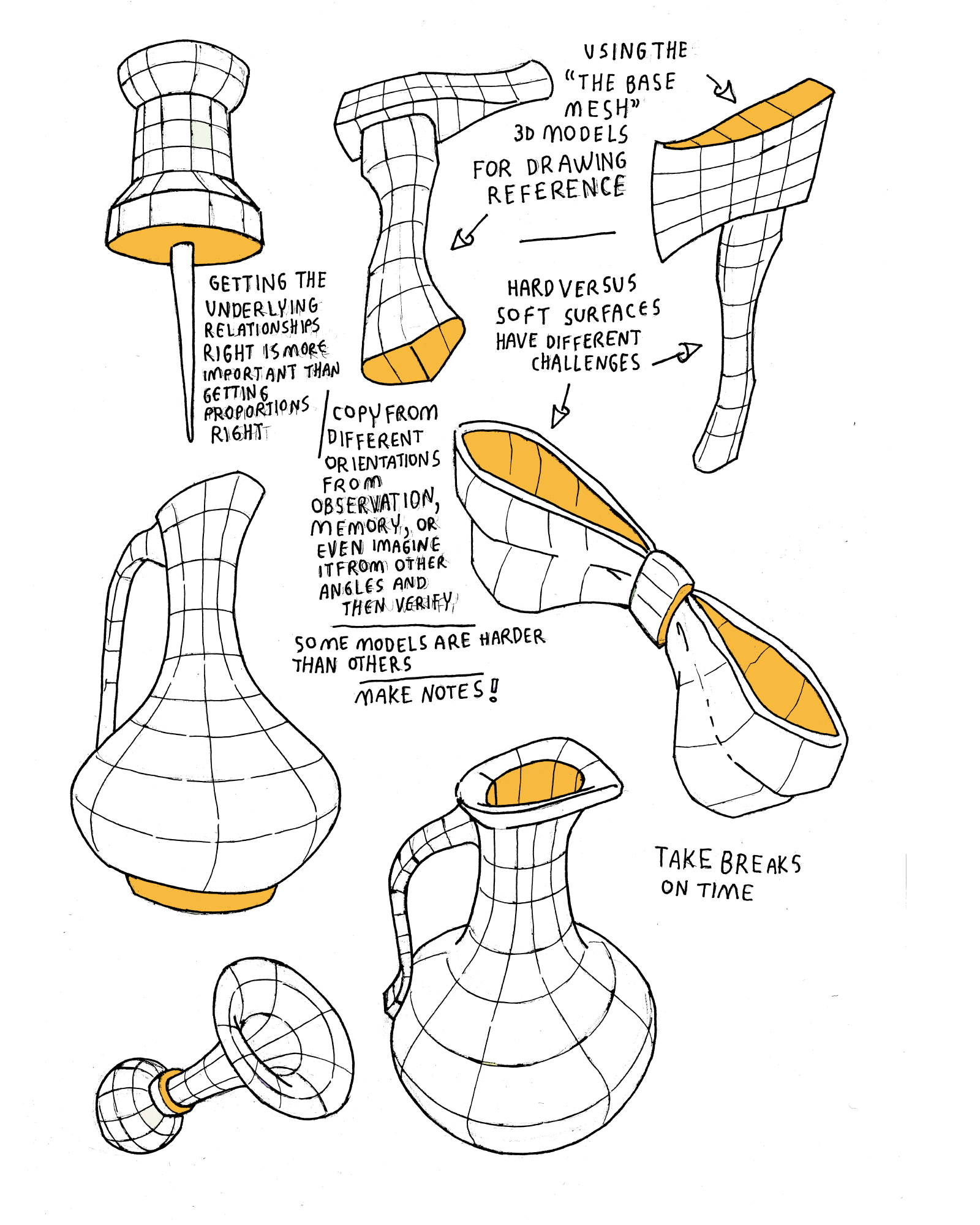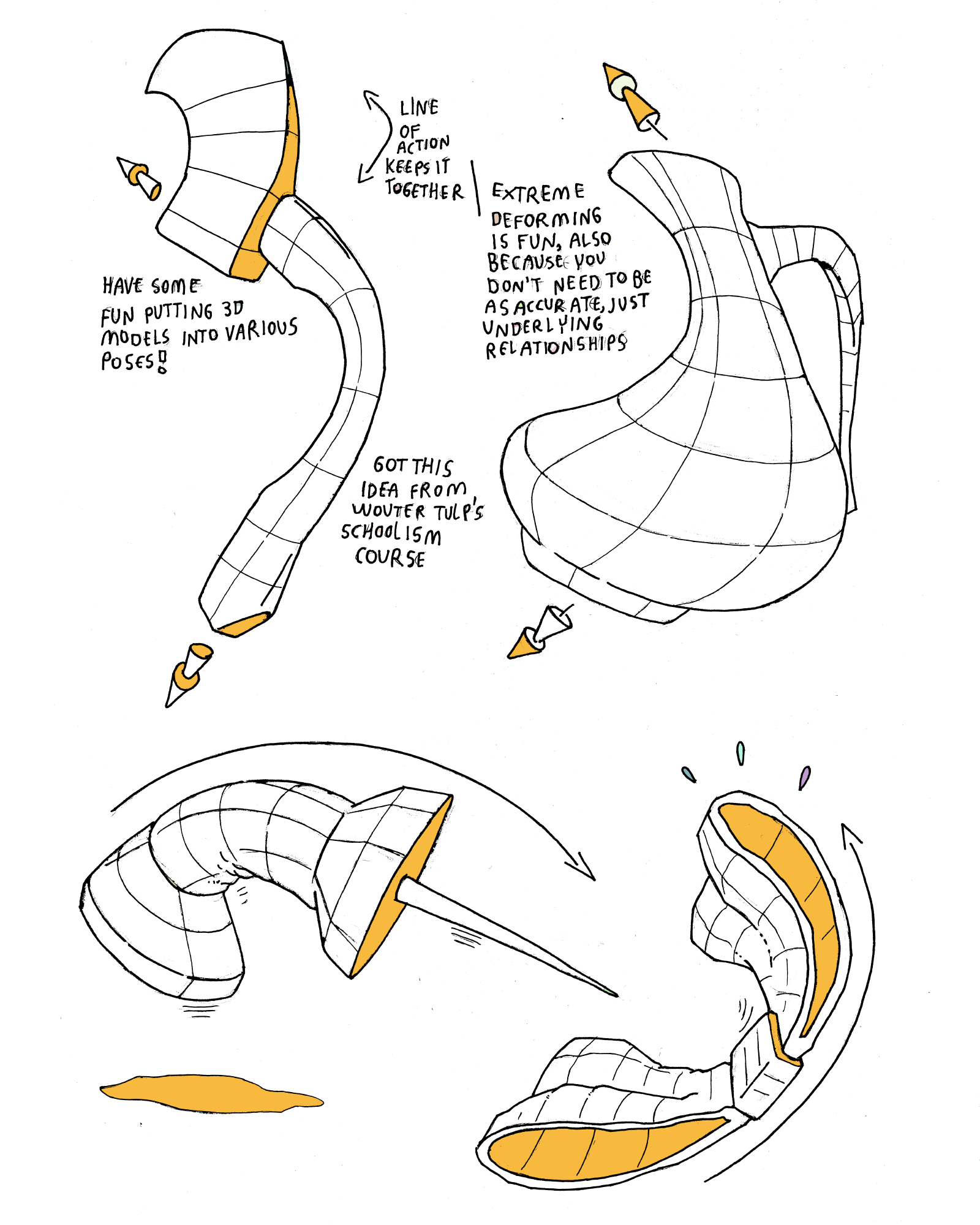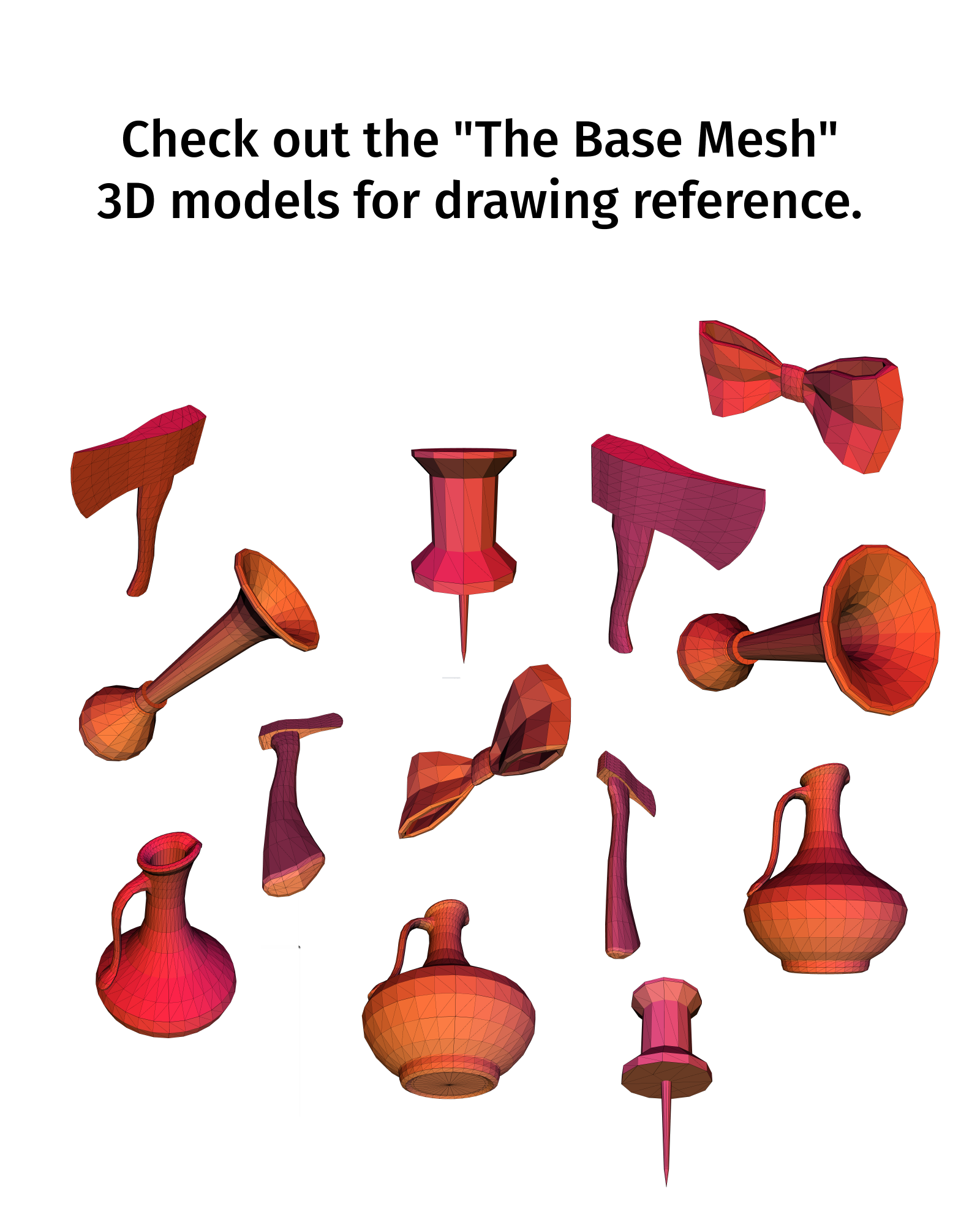#66 - Become A Better Artist By Reading Non-Art Related Non-Fiction Books?
You can also listen to an audio version of this article over at my podcast:
Podcast Episode 1
or listen to it while watching this Youtube video:
YouTube Video



Something New!
As you may notice, I am starting to experiment with podcasts. This is because it can be great to listen to something while drawing. YouTube is not ideal for this because there is a visual component: it wants you to watch video. And then you can’t draw.So one thing I made is ArtPodPlay . It just selects a podcast episode for you from a curated selection of podcast shows. All you have to do is press play and start drawing. You can easily skip to the next one.
There are a few categories and a new playlist is generated for each daily.
As you can see, I also started making my own podcast episodes, but I am starting to think that might not be a good idea as it distracts me away from drawing.
The slides above were drawn while looking at 3d models from the amazingly cool new website, The Base Mesh. As the name suggests, these models are base meshes meant to be enhanced, but I find they are also perfect as a reference for artists because they are so obviously simplified. I find that when I use more advanced models, like models from the Sketchfab website, they tend to be more detailed, but just not detailed enough to give accurate information. And yet, at the same time, they are too detailed to work as simplified models. They are often simplified wrong if that makes sense. The Base Mesh models are perfect. I am willing to bet the maker of The Base Mesh models didn’t consider this use case!
I have created viewers for these The Base Mesh 3d models on my website , which you can use in your browser, even on your phone! For links, see the description. I planned for this video to be something you can listen to while drawing if you want to. Or, you know, zone out watching my sketches if you need a break between drawing sessions.
So, open a 3d model viewer , grab your drawing tools, and begin!
I am trying slide shows in my YouTube videos now, as they take up less space on my hard disk, and they are easier to make as I don’t have to shoot videos. Which means I have more time to draw also. And I’d rather you listened than watched! Because how can you draw while you WATCH videos?
I want to try to make videos you can LISTEN to while drawing, and I want to experiment with setting up a podcast since it’s about the audio. The audio version of this article is the very first episode.
See how I keep distracting myself away from drawing? Because audio is a whole new rabbit hole, I can fall into writing scripts, voice training, recording good quality audio, creating rooms with great acoustics, and editing the audio. All these things are not drawing; they distract me from drawing.
I want to draw more. I find myself distracted by social media and online drama. Social media has its great sides too! Many things are amazing, and I would not have discovered them without them, and they made me a better artist.
I’m reading the book Good Strategy Bad Strategy by Richard Rumelt. I haven’t finished reading it, but it is a good book. It is funny that he sounds like an older get-off-my-lawn type in the book, but that’s just his frustration at having seen businesses deploy so many bad strategies so often: setting a goal and hoping for the best. He outlines what a proper strategy should look like, and you can use it to solve the difficult problems you run into, including art-related problems.
I’m applying it now to what I do. I want to make more time to draw. But that’s just a goal. And thinking positively will not manifest the desired outcome. Instead, I isolated the problem first: I find it hard to start. This is because it is hard work, and procrastinating is easier, and because of this, I get distracted by social media a lot. Hard practice itself is not as much fun. And I am regularly disappointed with the result, making it even harder to start.
And so I came up with a plan of attack: I removed social media from my mobile devices. I still have my accounts, but I must fire up a desktop computer to check them out. And I considerably cleaned up the spaces around me and optimized them for art creation. I have a fixed space where I work. I sit there and put on some audio on my iPad. This may be a YouTube video you can listen to, like this one, or maybe I may decide to listen to a podcast or choose some music to listen to. The iPad also doubles as a screen I can use to look at reference images. I’m only listening to the iPad, after all.
I won’t say what I listen to because there is no point. Your taste is probably different, so you will want to find your preferred audio to listen to. Maybe you prefer absolute silence or the buzzing sound of a place where people come to drink coffee and work on a laptop.
At my drawing table, I have my drawing tools and Nothing else. I can only draw there, and I always draw there, so starting drawing when I sit down there has become a habit. A Pavlovian reaction. Seating myself there triggers the drawing habit.
I then just start drawing on cheap scrap paper with a cheap pen, telling myself I am just doodling. That takes away the pressure of having to draw something ‘good.’ And the thing is that after I fill a sketchbook page with sketches, the page DOES tend to look good! Lively sketches are way more pleasing to look at than stiff finished pieces. I sometimes sketch with ballpoint pens because they are so fun and easy to use. But ballpoint ink tends to fade over time, and since sketchbook pages can look so cool, I want to be able to look at them for many years. So I work mainly with a black fine-liner now. This gives me flexibility; I can draw thick and thin lines. The pens are cheap; it’s okay if I should lose one.
Also, with black ink, you must commit to each line, including the ones that are ‘wrong.’ This ironically makes me less precious about the drawings. There WILL be mistakes in them, and that is fine. The sketchbook pages overall tend to look great.
I won’t show these pages because I want to be free to experiment. If there is even a hint that I may show these pages to others, I stiffen up, feel resistant to start drawing and try to reach for social media instead.
Not showing my sketchbook pages to other people keeps the stakes low and makes it easier for me to start drawing. No one will see it.
Another advantage to drawing directly in black ink lines is that it is more challenging because you can not erase lines. You have to put all your concentration and attention into every line.
If you make it harder on yourself, the other things become easier! If you draw directly in pen, drawing with a pencil and eraser becomes easier. And if you draw from MEMORY with a pen, then drawing from OBSERVATION with a pen becomes easier.
I got this idea from the book The Talent Code, which I wrote about elsewhere. In that book, the author describes how some soccer players train by playing soccer in a small room. It makes them work really hard on their footwork, and then when they enter a regular soccer field, they suddenly feel they have oodles of space around them, and playing regular soccer has become that much easier for them.
And that is my current approach, and I got that from the book Good Strategy Bad Strategy. A goal is just a goal. Analyze the problem, and then formulate a plan that is a focused and relentless attack on that problem.
A goal is just a goal, and a goal is not a strategy. A strategy is when you analyze a problem and then formulate a plan for how to solve that problem through a set of plans focused on that specific problem and designed to solve that problem.
My goal is to draw more. The problem I run into is that I find it hard to start, and because of this, I get distracted by social media a lot, and I plan to employ methods that lower the barrier to starting, and to make it harder for myself to access social media.
The videos and podcasts I make may seem like a distraction away from me drawing, but it gives me an artistic purpose: it gives me a reason to draw: to draw from studies which I can show in the video. And before I make the final form studies, I must practice them on scrap pieces of paper. And, frankly, it is creative too. More so than doom-scrolling on social media, at least.
So long story short, yes, you, as an artist, can learn from non-art-related books! And often far more than you’d learn while doom-scrolling on social media. It’s insane, isn’t it, that we would instead consume that fast food for the brain that is social media than feasting on the vast buffet of the top quality gourmet food for the brain that is books!
The algorithms are the thing that causes problems.
The algorithms reward click-bait titles, thumbnail images, drama, and tricks to get people to watch longer and more posts.
For this text, for example, I created a title for YouTube that will hopefully make people curious to learn more and click. The title is “Better Artist Through WHAT?”
For my newsletter, the article doesn’t have to be that clickbaity. The people who see it know me and know before they even open the article if they want to read it. There I give the much more descriptive and much less clickbaity title “Become A Better Artist By Reading Non-Art Related Non-Fiction Books?”
This article delivers on both titles, so the former is not really clickbait. But it is telling that you have to use a more seductive approach in the former and that a more informing approach works better in the latter. The former feels wrong; it feels manipulative as I try to get the audience to click on a link because they are curious about the answer to a question: Better Artist Through WHAT?
But if you don’t do it, then people don’t open the video, and then what’s the point of posting the video, you know? All the successful YouTubers you watch must be doing this; otherwise, you wouldn’t be watching them because you wouldn’t have found them.
I just happened to talk with someone today who is an editor at a large newspaper in my country. He works on the front page of the paper version but was now assigned to work on the newspaper’s online version. He told me he was shocked at how there was a perverse incentive to create click-bait titles for the online versions of the articles.
With the paper version, you don’t need to do that.
Customers have already paid for your subscription and receive the newspaper daily. The dead tree version may be worse for our environment, but it is better for the quality of the news reporting. You can see the headlines online and perhaps read two or three articles, but then you hit a paywall.
The article titles are designed to pull you past the pay wall, they are supposed to do some of the marketing heavy-lifting, and this is detrimental to the way information is provided and can, frankly, be detrimental to the quality of the information provided.
A great example of this is the blogging site medium.com, where the algorithm aggressively forces writers to churn out the same types of articles repeatedly. When articles also have to do some marketing heavy lifting, they are forced to become clickbaity and sensational, as opposed to informative.
Paying for a subscription does not guarantee you will get quality information in that case, as the articles still need to do the marketing heavy lifting to pull in other customers, as you can see with medium.com. Or YouTube, for that matter. A subscription to YouTube removes the advertisements but not the sensationalism, the drama, and the heart-tugging cat videos.
In contrast, the website masterclass.com , for example, is an educational video platform, and it is subscription-based, just like the dead-tree version of a newspaper. You already paid for access. Masterclass doesn’t have to do any tricks to get you to pay up anymore. They already have your money.
It also has videos, highly instructional ones, by the way, very much worth listening to! These videos are a step or two above most YouTube videos when it comes to the quality of the information presented.
And the videos are edited so wonderfully minimalistic! Just a straight, calm voice, very little music, no click-bait titles or thumbnail images, no fast-paced editing to keep you dazzled and your eyes glued to the screen, forgetting to unlock your eyes, no calls to action, no please-like-and-subscribe nonsense—just incredible insights from experienced people.
Masterclass doesn’t have to do all those things you need to do to please an algorithm. They already have your money, and they put out great educational videos that are wonderful to listen to while drawing.
The first time I saw the Masterclass videos, I was like, ‘oh! You can make binge-watch-worthy videos without resorting to bells and whistles!’
Marshall Vandruff put his amazing Bridgman Bootcamp videos on YouTube for free ! It must be one of the top learning resources on the platform.
He has no marketing bells and whistles around his videos and, consequently, not many people have seen it!
His videos have been seen nowhere near as often as Jazza’s videos with all the sensational and clickbaity titles and thumbnail images. Take a wild guess which of the two channels is more informative than the other.
Algorithms reward sensationalism and drama over the quality of information.
And to bring this full circle, it is this sensationalism that I am now trying to excise from my life so that I have more time to draw. It is a part of my strategy plan to tackle the problem of needing more time to draw. An approach I was able to formulate after reading the book ‘Good Strategy Bad Strategy,’ and it is making me a better artist for it.
I want to avoid doing marketing in my articles, videos, or podcasts. This may mean that few people see it. But is that bad? I am missing people that would rather be distracted by sensationalism than hear me say, ‘listen, you need to draw. You can listen to my podcasts or videos, but you need to draw.’ Am I not doing artists who lose time procrastinating on social media a favor with that message?
The visuals for my YouTube videos will be designed for that, too; I will avoid using distracting visual spectacle from now on. There is enough of that already.
It can be seen as a moral question, also. Is it okay to trick people into seeing your work? No? And what if you think that what you are offering is genuinely helpful to others?
I think what I have to offer is helpful to others, but I will try to avoid the trickery part from now on. It just feels wrong.
I did a quick foray into the short-form videos recently, making infamous Shorts and the Reels, but these really only seem to do well if they are designed to be distracting entertainment for the masses.
Which is not bad in and of itself, but, you know, you should be drawing and not endlessly looking at short-form entertainment, and I should be drawing, and not endlessly CREATING short-form entertainment!
We both lose drawing time with that stuff! Time we could have spent drawing.
My plan is for the stuff I put out to remain free, but there is something to be said for getting people to pay for your things: they take it a lot more seriously if they paid for it. After they purchase your things, you don’t have to resort to spectacle anymore to get them to take a look. You can leave out the marketing cruft and provide the information.
The Schoolism course videos I’ve seen, like the Wouter Tulp ones I am watching now, thankfully also skip marketing. Schoolism is an educational site for artists —they are not paying me to say this, by the way. It is a wonderful resource, and it is also subscription-based.
Schoolism already has your money, too, so it doesn’t have to waste time marketing to you and can focus on providing quality courses. Their course videos don’t have to do any marketing heavy-lifting. They dive right into the subject and end, with you longing for more and tempted to binge-watch the next lesson.
The videos end like a chapter in a book would end; almost abruptly, without saying goodbye, without a call to action. It ends, and you feel satisfied and want to dive into the next chapter to keep binge-listening.